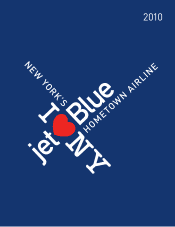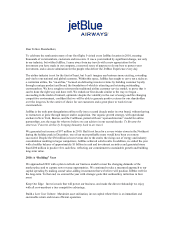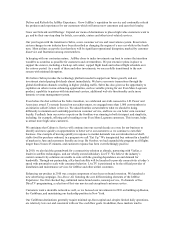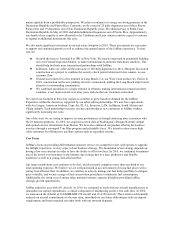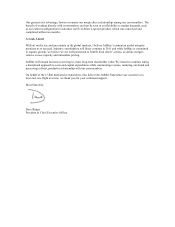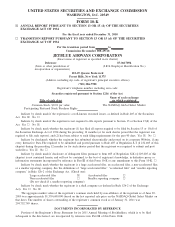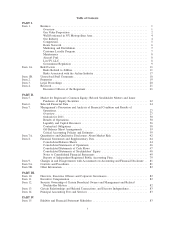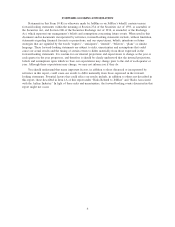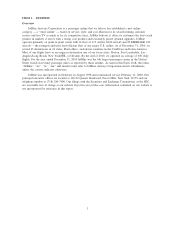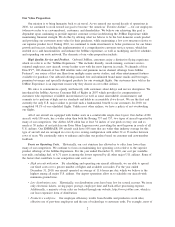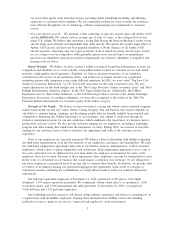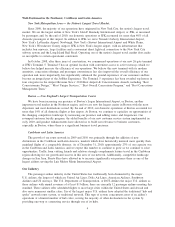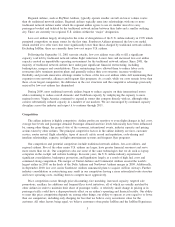JetBlue Airlines 2010 Annual Report Download - page 4
Download and view the complete annual report
Please find page 4 of the 2010 JetBlue Airlines annual report below. You can navigate through the pages in the report by either clicking on the pages listed below, or by using the keyword search tool below to find specific information within the annual report.
mature quickly from a profitability perspective. We plan to continue to leverage our strong presence in the
Dominican Republic and Puerto Rico. Currently, we fly a total of 25 daily departures out of three Puerto
Rican cities and 19 departures out of four Dominican Republic cities. We added service to Punta Cana,
Dominican Republic in May of 2010 and added additional frequencies out of Puerto Rico. Approximately
one-fourth of our capacity is now allocated to the Caribbean and Latin America and we expect to continue
to expand to additional destinations this year.
We also made significant investment in our real estate footprint in 2010. These investments are necessary
to support our continued growth as well as enhance the ground aspect of the JetBlue experience. To that
end, we:
Secured the lease to Terminal 6 at JFK in New York. We may be interested in potentially building
our own Federal Inspection Station, to make international-to-domestic transitions seamless. This
should help facilitate more international partnerships with JetBlue.
In Boston, where we achieved the milestone of 100 daily departures in 2011, Massport has started
construction on a project to combine the security check points behind our ticket counter, to ease
customer flow.
Ground was broken for a new terminal in Long Beach, CA, our West Coast anchor city. Earlier in
2010, construction on the new parking structure commenced, making the Long Beach airport more
attractive to surrounding communities.
We combined operations to a single terminal in Orlando, making international connections there
seamless, a vast improvement over prior years and one that our customers welcomed.
We expect our footprint in these key regions to continue to grow based on demand for the JetBlue
Experience within the Americas, supported by our other airline partnerships. We now have agreements
with Aer Lingus, American Airlines, Cape Air, EL AL, Emirates, LAN, Lufthansa, South African and
Virgin Atlantic. Each partnership increases revenue and introduces new customers to JetBlue without
significantly increasing our costs.
One of the ways we are trying to improve revenue performance is through attracting more customers who
fly for business purposes. In 2010, we acquired coveted slots at Washington’s Reagan National Airport
and opened six new destinations from Boston. We have also enhanced our product offering for business
travelers through a revamped True Blue program and refundable fares. We intend to attract more high
value customers by offering new ancillary options such as expedited security.
Cost Focus
JetBlue’s focus on providing differentiated customer service at a competitive fare, with options to upgrade
the inflight experience, is a key aspect of our business strategy. The foundation of our strategy depends on
having a low cost structure in order to have the ability to offer low fares. In 2010, we continued to maintain
one of the lowest cost structures in the industry due in large part to a lean, productive and flexible
workforce as well as a young, fuel-efficient fleet.
Our largest stand-alone cost continues to be fuel, which currently comprises more than one-third of our
total operating expenses. We believe we are well positioned in an environment of rising fuel prices with a
young, fuel-efficient fleet. In addition, we continue to actively manage our fuel hedge portfolio to mitigate
price volatility, and we use a range of fuel conservation procedures to minimize fuel consumption.
Additionally, the rising cost of energy helps maintain industry capacity discipline providing JetBlue
strategic growth opportunities.
JetBlue ended the year with 161 aircraft. In 2010, we continued to work with our aircraft manufacturers to
rationalize our capital expenditures, a critical component of maintaining positive free cash flow. In 2010,
we announced the deferral of 16 EMBRAER 190 aircraft and 16 A320 aircraft. These actions substantially
reduced our aircraft commitments in the near term, smoothed out our future debt and pre-delivery deposit
requirements and better matched our order book with our network demands.

